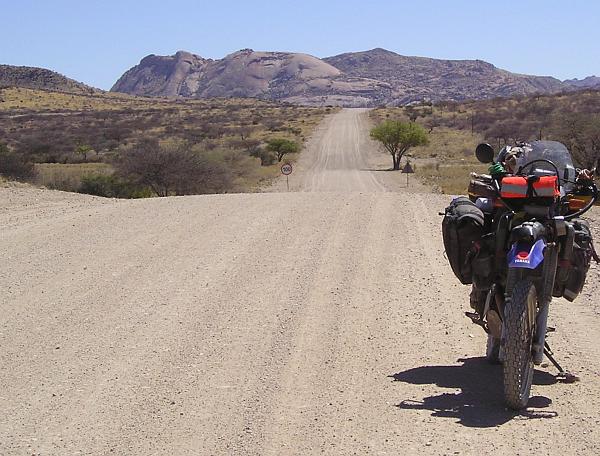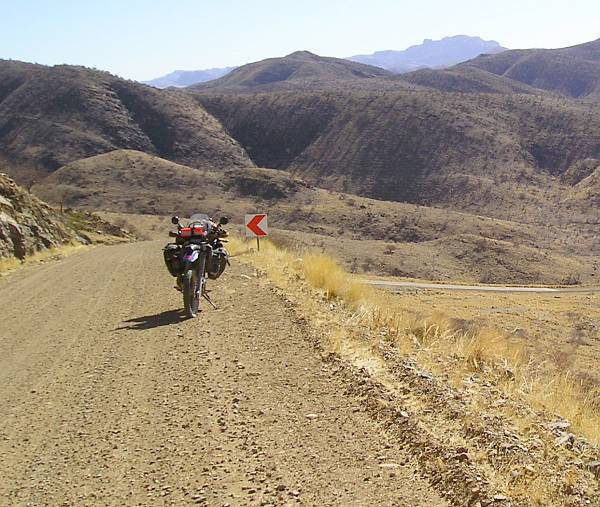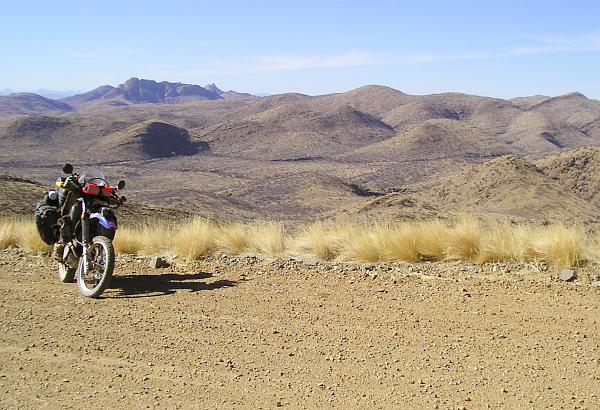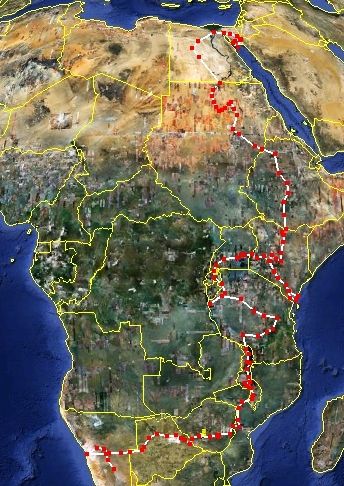The Best Of Times, The Worst Of Times
A tale of two days.
Let's start with the worst of times, part one.
The morning after exploring the coast and desert around Swakopmund I decided to return inland and then south towards South Africa. First I needed some cash from the ATM.
You know that feeling you get, when you're a long way from home, in a strange country, in a far-away land that everyone says is dangerous, and you go to put your cash card in the ATM but there's no cash card?
"Don't panic, Mr. Mainwaring!"
Well, it's not easy and I supposed I failed a little.
Firstly, if it's gone it's gone, and I had a credit card, so I used that. But later it turned out I didn't need to.
With cash, I headed into town for petrol and to visit the big Yamaha dealer, just to look.
And I thought of where the card might be. Slowly it came back. I withdrew some cash the Saturday before from the bank next to the cafe where I parked the bike. I remembered it all being in small notes making a doorstep that just about fitted through the jaws and filled my pocket to bulging.
But no memory of filing away the plastic card. So I return to the bank, maybe I left it in the machine.
On the way was the police station - pop in there.
The attendant pulled out a huge cardboard box full of keys, cards, purses, spectacles, wallets and watches. But not my card.
But in the station there was a reminder of two things I'd not seen elsewhere in Africa. Posters all around the room imploring lorry-drivers not to pick up women touting at the roadsides, which reminded me of the other scene a few days earlier, quite a few women standing along the verge of the north-south motorway out of Windhoek, waiting for clients. As I said, the changes are slow and subtle.
So off to the bank, where the attendant at the enquiries desk picked up the phone and dialled an extension.
"Mr. Thomas?"
"That's right."
"Someone will be out in a moment with your card."
Phew! What a sense of relief.
My saviour appeared, saying he thought maybe the buzzer that tells you to take your card away with you wasn't working over the weekend.
"The machine pulls the card back in for safe keeping, here it is, sign here and here and let me photocopy your passport."
So that was all right then.
Then off to the Yamaha dealer. I thought it might be wise, if they have one, to buy a chain to carry as a spare. Eighteen thousand miles across tarmac, desert and dirt is quite a test of a chain, and although I'd only had to adjust it once, you never know.
They had one, so I asked about guide rollers.
Yes, they have those too, after-market ones much stronger than the original. By the way, they recently heard that four brand-new TTR250s had been found in Durban and they had earmarked two of them to put in their showroom.
With things looking good, or at least better than when I tried to locate my plastic earlier, I asked about the routes back inland.
There are three. The tarmac I'd come in on that takes a big loop to the north through Karibib, or a dirt road due east to Windhoek (which I'd explored a bit, finding the "Dust free" sign the day before), or another much longer dirt road south-east to Mariental which is on the main road south to South Africa.
I'd already asked at the hotel and the consensus there was that the due east road to Windhoek was fine, shorter than the tarmac and much more scenic. (That tarmac road, although not straight, had been pretty much as featureless as the rest of the Trans-Kalahari from Botswana).
"Ordinary cars do it all the time, you don't need 4X4 or anything like that," they assured me.
The advice in the Yamaha shop was the same.
"The south east road is a long way. There's somewhere to stay along it, but lots of bad corrugations further east." I'd already discounted that option because of the distance.
"Don't go on the tarmac, you've already seen how boring that is. The C28 direct road to Windhoek is fine. You'll have a great ride. It's flat straight desert at first but then there's the Boshua Pass (which I'd seen signposted), then you're up in the mountains to Windhoek. Two hundred miles in all. We wouldn't go any other way."
All this from a Finish ex-pat Yamaha dealer who wanted to know about my ride to North Cape and Lapland on a Yamaha Serow. He'd never heard of a Serow but knew straightaway what an XT225 was (its other name).
So that seemed fairly sound, just needed petrol and then back to the "Dust Free Zone" and onwards and upwards over the Boshua Pass.
Except it was already eleven o'clock by then. But that's eight hours of light so should be OK.
The previous day I'd been as far as the 1km of dust-free tarmac and then returned. Today I continued beyond, on pretty good hard graded dirt and gravel, fairly straight but weird Namib Desert all around. Then another sign ditto, "dust free 2km ahead."
Tarmac again. And it went on and on, and on. About ten miles and I was thinking, "Hey, where's my adventure gone that they promised me. It's all tarmac!"
And another five miles. The lonely signposts still said Windhoek so it was the right road alright.
Then, a massive Uranium mining area with no-entry signs all over the place and huge trucks dotting the skyline. And the end of the tarmac, back on the good hard gravel.
And onwards deeper into the Namib, some strange scenes.

Distant mountains and trees hang in the sky above the mirages.





Approaching halfway we start to climb up into some foothills.
The road a bit stonier but still fine.

The volcanic activity returns. I'm pretty certain this is lava solidified in mid-flow. The larger ones are often hollow inside forming lava tubes.
Around here, groups of gazelle appeared, leaping along across and away from the road as I appeared. At one point a particularly large one, I thought maybe a springbok, came bounding alongside on the left of the road, overtook me and bounded across a little in front. Then disappeared off to the right. It had a very determined look about it, with shoulders sort of hunched as though it was on a very serious mission. I was going at a shade under 30mph at the time. Maybe it was just a race.

Deeper into the Namib and further into the foothills.

The volcanic stuff looking back.

A little before halfway, the turning north to Karibib, the Boshua Pass is dead ahead.

Two miles or so before the pass.

The sign says "Steep Gradients Ahead. No Trucks Trailers Caravans."
That's got that lot out of the way then.
But - one mile later..........

The sign said nothing about punctures.
Ignition off. Gloves off. Hat off. Coat off. Tools off. Wheel off. Tyre off. Tube off. As quickly as you can say it ideally - but this added an hour to the journey. So not too bad, but serious doubt now about reaching Windhoek before dark. The Worst Of Times part Two.
But, if you have a puncture in the desert, the Namib is the place to do it. Not hot, in fact the temperature is very pleasant.

Puncture mended, the climb through the Boshua Pass.

Steep and vertiginous. On some of these inclines the little loaded Yamaha came close to needing some clutch slip to reach the top.
The downhills were just as tricky. The tyres were getting quite a battering on the stones and rocks. I hoped my faith in the repair I did back in Kenya, to the inner tube that was now inside the front wheel, was not misplaced.


Road surface deteriorating amongst the hills. Shadows lengthening.
Like the teacher appearing when the student is ready, stuff you really need has a habit of turning up in time.
Well, it did on this occasion in the form of Harmonie Camping, a little way past the pass and about two-thirds to Windhoek. And not on any map or internet site I've seen.
Everything you need for an overnight including electricity and hot shower. Maybe it's true what they say, there's nowhere left in the world where you can have a true adventure.......
Even a little table made from an old cable drum on its side, just right for three patches and a breakfast in the morning.

I had fitted my spare inner tube to fix the puncture, but the damaged one has to be mended as soon as poss, specially in this environment.
The tyre went down just after I hit something quite large and unseen, it must have been a big rock the same colour as the road surface, or maybe I just didn't see it.
Anyway, it made two small tears in the side of the inner tube. How, I don't know, but I do wonder now about the usefulness of these heavy-duty 5mm thick tubes.
Because when I removed the tube the day before, the first thing I saw was a tree thorn that had pierced it, with a bit of the thorn still in the tyre.
But that must have pierced the tube as I removed the tyre, the same as happened when Caroline changed her front tyre in Egypt.
So these tubes may protect against pointy things in the tyre going right into the tube, but on two occasions now they have eventually made a hole during all the huffing and puffing of removing the tyre. Maybe at least that happens when you've got the tyre off anyway, but these tubes also weigh a serious amount more than ordinary ones and I wonder if it's worth it.
So the net result was three holes to mend, then pack the tube back where the spare one belongs. And also to report on The Worst Of Times part Three. After replacing the wheel the day before and packing up everything, everything was certainly on the bike. But chains are heavy things and the road over the pass was fearsomely steep and bumpy. Well, the new chain, wedged under the bungy straps, fell off and is in the road somewhere along the Boshua Pass, so at least I don't have the weight of it any more.
Ready to depart, we continued a short distance to This:

One of many cattle grids, and a sign.

The Boshua Pass leads up to the Khomas Highlands, and the adventure continues. With a name like that maybe you'd expect it to.
The road simply got worse and worse. More and bigger stones, loose gravel, and the arrival of corrugations. Sometimes pretty serious, requiring braking down to almost walking pace. And these too became worse and worse.
We were only about twenty miles from Windhoek now but still no traffic. For the whole distance since the campsite nothing had overtaken me and only about three cars went the other way. The day before, the score was one vehicle overtaking me and maybe five going the other way, in about 120 miles.
So I got to thinking, where are all these people who 'always use this road - wouldn't go to Windhoek by any other way'?
Where are the 'ordinary cars'? They'd all been 4X4s with half-metre-wide tyres.
Yes, it's like Australia still, everyone has a lot of brash pioneer spirit. "No worries mate! That road'll get you to Windhoek before you know it. My Granny drives it everyday to get to the corner shop!"
And as usual, just as the corrugations grew so bad I thought I might have to get off and push, the Star of the East appeared. Tarmacadam!
Never is relief so immediate!
"Well, that was quite a two-day adventure! I'm glad all those people recommended this road otherwise I would have just gone on that boring old road round to the north. Perhaps we can make Mariental before sunset."
I headed straight for the western bypass, turned south, and hoped for a simple ride to some nice accommodation for rest and recovery.
So here I am at a nice B&B just outside Mariental, well on the way to the South African border, now about three day's riding away.
But there's still no rest. Today was oil-change day. And the front brake pads as well, which I noticed, when mending the puncture, were in need of replacement. They've done eighteen and a half thousand miles across mainly African roads, so you may expect the caliper sliders to be a little jammed up with red dirt, and they were.
And just to finish, although I had a reasonably good look at the front tyre when it was off of the bike in the desert, I also spotted, while changing the brake pads, a small but deep split in the tread (which is pretty worn down now, just about legal in the UK I think). No doubt caused by hitting whatever it was that I hit.
I'd already decided that both tyres will probably need changing before Cape Town, so now I'll be looking for a front replacement in Keetmanshoop, the next main town along the way. It's probably not an emergency thing as this split tyre has, after all, survived the worst third of the road to Windhoek.
There'll be another oil change needed before Cape Town and I think the total mileage by the finish line (wherever that is) will be over twenty thousand.
I think that's over the 'qualifying distance' to be ridden for an around-the-world journey. So that'll do for now.
I made a map on GoogleEarth of the route so far:

